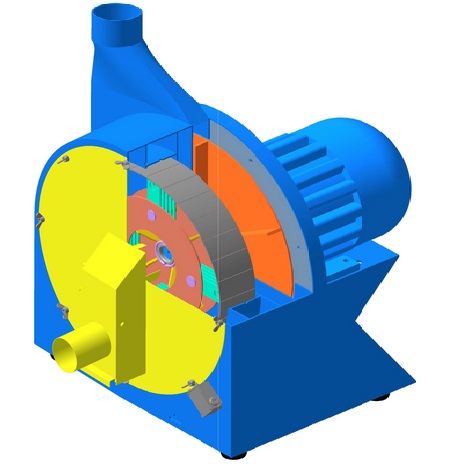Creating a 220 Volt Homemade Generator
Today, we’ll build a homemade generator that operates at 220 volts, featuring two designs based on a trimmer engine and a 12-volt car generator. The power output of such a setup can vary from 1 to 2 kW, depending on the engine’s and the car generator’s power. The output voltage is 12 V, but it can be increased to 220 V using an inverter.

220 Volt Homemade Generator with a Trimmer or Chainsaw Engine
What you’ll need:
To assemble a generator, you’ll need a gasoline engine from a trimmer or chainsaw. It’s preferable to use a 4-stroke, but a 2-stroke will also work.
- A car generator with a built-in voltage stabilization system, suitable options are from VAZ, Moskvich, Volga – they deliver maximum power at 5000 rpm.
- A 12 V battery. It’s only used to start the generator. Without it, the generator won’t produce electricity, as initial excitation requires current in the winding.
- An inventory voltage inverter – UPS.
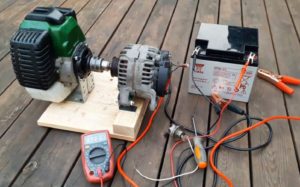
Engine Power and RPM Characteristics
- Trimmer (lawnmower) engine – 0.5…2 kW, 8000…9000 rpm;
- Chainsaw engine – 1.5…3 kW, 9000…12000 rpm;
- Tiller engine – 3…9 kW, 2000…3000 rpm.
Example calculation:
A lawnmower gasoline engine has a power of 2 kW – 9000 rpm. A VAZ generator produces 14V current up to 60A at 5000 rpm. The power of the generator is 14V x 60A = 840 W.
The next device is an inverter voltage converter, a regular UPS of 350 – 1000 Watts will suffice.
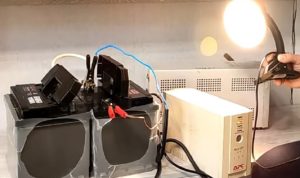
The power you receive depends on the UPS you use. For instance, a 350W UPS can simultaneously power 10 LED lamps in the house (70W), run a boiler pump (80W), turn on a laptop (50W), and still have enough for charging smartphones. It won’t handle appliances like microwaves, refrigerators, or boilers!
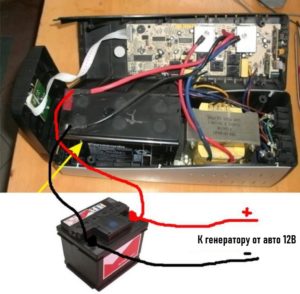
Assembling the Electrogene
Assembling the generator is straightforward. The shaft is cut, machined on a lathe, and threaded to fit the chuck. Then the chuck is installed and clamps the shaft.
All components are then mounted on a wooden stand. It’s crucial to ensure reliable fixation of all units so that their axes are in one plane and rotation is as smooth as possible.
Next, start the gasoline engine, connect the generator to the battery, and use a voltmeter with a lamp to check its efficiency. Connect the generator’s + and – wires to the UPS, press the UPS’s power button, and you will have 220V AC in the UPS socket.
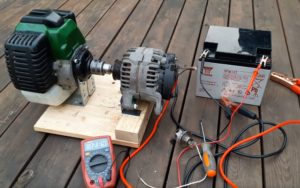
Which Engine Can Be Used as a Generator?
Any internal combustion engine, such as diesel or gasoline, can be used as a generator. It can convert mechanical energy from the engine’s rotating shaft into electrical energy to power electrical equipment or charge batteries.
What Kind of Generator is Needed for Home Use?
For home use, the most suitable type of generator is an inverter generator. They are highly efficient, have low noise levels, and can provide precise voltage and frequency. They are also portable and can serve as a backup power source during electrical outages. It’s important to choose a generator based on your individual needs and power consumption at home.
What Power Should a Generator Have for a Refrigerator?
The recommended power for a generator to run a refrigerator depends on its size and energy consumption. On average, a refrigerator using about 100 Watts will require a generator with at least 800 Watts. However, it’s always best to verify the energy requirements from the refrigerator manufacturer or its manual.
Can You Use 95 Octane Gasoline in a Generator?
Yes, you can use 95 octane gasoline in a generator, but it depends on the user manual’s specifications. Some generators are designed to operate only on specific types of fuel, such as high-octane gasoline (above 87). Always read your generator’s user manual and ensure compliance with fuel requirements.
What Shouldn’t Be Connected to a Generator?
Some electrical appliances and devices should not be connected to a generator as they may damage the generator or lead to dangerous situations. This includes:
- Devices with high electrical consumption, such as air conditioners and electric heaters.
- Devices with unstable electrical input, such as computers and gaming consoles.
- Devices requiring stable and precise power, such as medical apparatus or lighting equipment.
It’s important to remember that generators are intended for providing electrical power in emergency situations and should not be used as a permanent power source. Always consult the generator’s manual before connecting anything to it.
How Long Can a Generator Run Continuously?
The duration a generator can run without interruption depends on various factors like the generator’s power, fuel type, operating conditions, and technical condition. On average, generators can operate for 8 to 20 hours without interruption, depending on their power and fuel type. However, this may vary based on the specific model. Always check the operation manual for precise instructions on operating and maintaining your generator.
220 Volt Homemade Generator Video Tutorials


